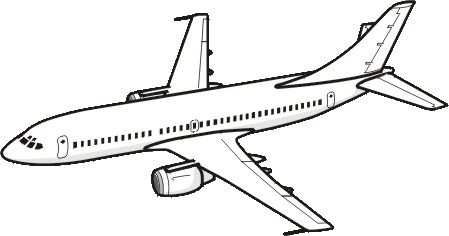Peter:'So now, I am going to ask you about some other parts of an aircraft.'
Juan:'Ok.'
Peter:'On the wings there are various panels/parts which are used to control the aircraft.'
Juan:'To help the plane to take off, slow down and to move left or right.'
Peter:'That's right. So, what are the name of the panels/parts attached to the back part of the wings next to the fuselage that are used to help the airplane take off from the runway and to slow it down when landing?'
Juan:'I think they are called the flaps. But they are not the only panels/parts attached to the back part of the wings, are they?'
Peter:'No they aren't. There is a panel/part attached at the back of each wing near the tip/end which are used to turn the aircraft either left or right. Do you know what these are called?'
Juan:'I think they are called the ailerons.'
Peter:'That's correct. And what about the panels/parts on the top of the wing in front of the flaps, which are used to make an aircraft descend/go down more quickly?'
Juan:'I know this. They are called the spoilers. They are also used to slow the plane down when the plane has landed on the runway.'
Peter:'They do. So now let's look at the back or tail of an aircraft. There are two types of small wings attached to the fuselage and are fixed (they don't move). One which is vertical and the other which is horizontal. Do you know what these are called?'
Juan:'The one which is vertical is called the fin.'
Peter:'And the small wings which are horizontal which are under the fin at each side of it?'
Juan:'They are called the tailplanes.'
Peter:'Perfect. Although neither the fin and the tailplanes move, they each have a panel/part which does. So what is the name of the panel/part at the back of the fin which is used to help the aircraft turn left or right?'
Juan:'It's the same as on a boat or ship, it's called a rudder.'
Peter:'That's right. So to end, tell me what the names of the panels/parts are at the back of the tailplanes?'
Juan:'They are called the elevators.'
Peter:'And what are they used to do?'
Juan:'They are used to make the nose of the aircraft either point up (so the plane climbs/goes up) or point down (so the plane descends/goes down).'
Peter:'That's correct. Well done.'



 , you can find extra information about the part (e.g. what it is, what it is used etc...) and a Spanish translation. In the second,
, you can find extra information about the part (e.g. what it is, what it is used etc...) and a Spanish translation. In the second,  , is where you can listen to the pronunciation of the name.
, is where you can listen to the pronunciation of the name.